How Did Wwii Change The United States?
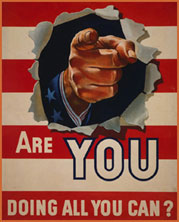 Every aspect of the lives of Americans was affected by the state of war. There was an increased wave of patriotism immediately post-obit the bombing of Pearl Harbor. Americans from all walks of life participated in acts of patriotism that encapsulated the United States during the war.
Every aspect of the lives of Americans was affected by the state of war. There was an increased wave of patriotism immediately post-obit the bombing of Pearl Harbor. Americans from all walks of life participated in acts of patriotism that encapsulated the United States during the war.
The Function of War Data managed a campaign to encourage patriotism through a serial of posters. Click on the link below for examples of posters from World War 2 from the U.S. National Archives and Records Administration.
World War II Posters
Newspapers and radio programming were geared toward reporting the state of war and keeping civilians informed. There were songs and movies produced with patriotic themes. Actors, singers, and other entertainers traveled across the country to entertain the troops.
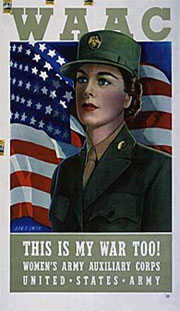
Source: Affiche, Poster 133, Minnesota Historical Society
Men and women voluntarily enlisted into the armed forces in tape numbers. By the end of the war, at that place were more 12 one thousand thousand members of the United states Armed Forces. More than 350,000 women served in the U.S. military and more than seventy,000 served as Army and Navy nurses.
In 1942, President Roosevelt created the Women's Auxiliary Forces, which included branches of the military specifically for women. The following is a list of Women's Auxiliary Forces:
- Women's Army Auxiliary Corps (WAC or WAAC)
- Women Air Forcefulness Service Pilots (WASP)
- Women Accepted for Volunteer Emergency Service (WAVES)
- U.S. Declension Baby-sit Women'due south Reserve (nicknamed SPARS)
Women were not allowed to participate in armed conflict, and most women in the military served in roles that were considered traditional female jobs. These jobs included clerks, secretaries, and post sorters. These positions were important to military functions because they kept the menses of advice moving. Women who served in the medical corps faced more than danger because their piece of work was normally performed closer to the front end lines.
Although all Americans were working toward a victory in World War II, many of the social problems that plagued the United States besides followed American troops to war. At the beginning of the U.S. involvement in the war, the armed services was segregated. African-American troops lived, worked, and relaxed in separate facilities. They had separate training and were then placed in split military units, which were led by white officers.
African-American soldiers were frequently assigned to supply units instead of gainsay. Although these soldiers were discriminated against at home and in the military, they proudly served their country in the war.
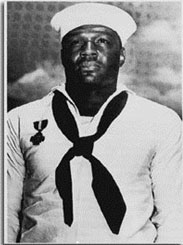
An case of such bravery came on the day that the Japanese attacked Pearl Harbor. Doris Miller was a mess attendant (cook) on the U.Due south.S.Westward Virginia at the time of the attack. Despite enemy strafing and bombing, Miller helped move his mortally wounded Captain to a identify of greater safety. He then manned and fired a machine gun against the attacking Japanese planes until ordered to leave the ship's span.
In the African-American community, Miller'south deportment were a source of pride. Miller connected his service in the navy until he died when the U.S.S.Liscome Bay was sunk past a Japanese submarine torpedo in 1943.
Source: Doris Miller, National Archives
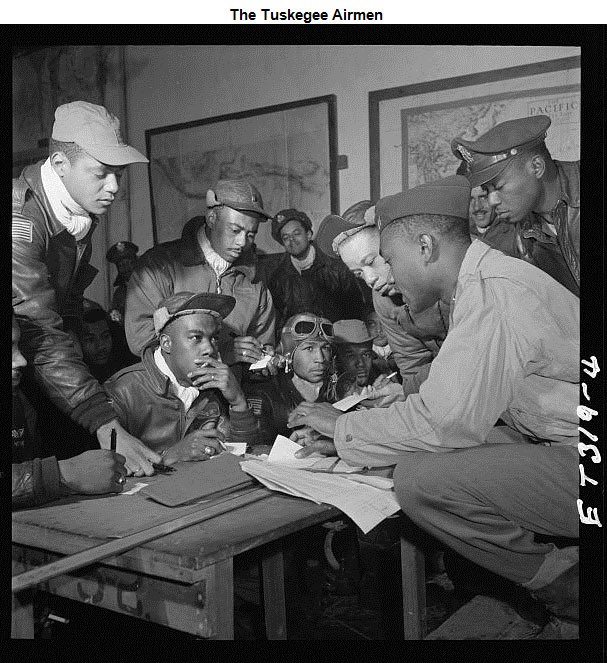
Source: [Photograph of several Tuskegee airmen at Ramitelli, Italian republic, March 1945], Tony Frisell, Library of Congress
During the time that well-nigh African American soldiers were relegated to duties such as cooking and cleaning, a heroic group of African Americans known as the Tuskegee Airmen emerged. The Tuskegee Airmen was a group of specially trained African-American combat pilots who studied at Tuskegee Institute in Tuskegee, Alabama. The Tuskegee Airmen were assigned the task of escorting American bomber planes flying missions over enemy territory in Europe.
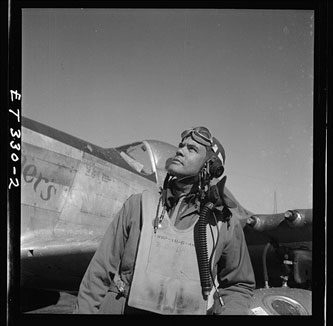
Source: Col. Benjamin O. Davis, air base of operations at Rametti, Italy, Toni Frissell, Library of Congress
Colonel Benjamin O. Davis commanded the Tuskegee Airmen. In combat over Europe, they shot down more than 100 enemy planes without losing ane of the American bombers they escorted. Davis would later become the first African-American full general in the U.S. Air Strength.
While segregation persisted in the military machine, some change came on the domicile front end. A. Philip Randolph, an African-American labor leader, presented President Roosevelt with a list of grievances regarding the civil rights of African-American workers in the nation'southward defence industry. Randolph planned a huge protestation march in Washington, D.C., if the demands were non met. Fearing such a protest would undermine wartime unity, President Roosevelt issued Executive Order 8802, banning discriminatory employment practices past Federal agencies and all unions and companies engaged in war-related work. Click on the link below to view a video about A. Philip Randolph and the March on Washington Movement.
![]()
Source: WWII & NYC: March on Washington, New York Historical Society, YouTube
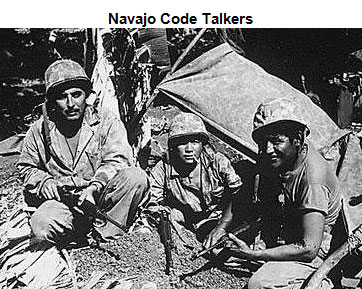
Source: Navajo Code Talkers, Bradipus, Wikimedia
A special group of American Indians called the Navajo Code Talkers was another group that made an important contribution to Earth State of war Two. The Navajo Indians were recruited to transmit and receive secretly coded radio communications for the U.S. Marines. This was essential considering enemy forces intercepted and listened to radio transmissions pertaining to Marine maneuvers and combat.
The Navajo Code Talkers developed a surreptitious lawmaking of communication based on the Navajo linguistic communication. The enemy was unable to decode the Navajo language, thus making the Navajo Code Talkers essential to the success of the Allies during World War Ii.
Over 500,000 Latinos (including 350,000 Mexican Americans) served in Globe War II. Unlike African Americans, they were non segregated into dissever units. Latino soldiers who were fluent in Spanish served an important office in fighting in the Philippines. Their noesis of Spanish was invaluable when serving with Spanish speaking Filipinos. In Europe, Latino soldiers from the 36th Infantry Division from Texas were amidst the offset soldiers to state in Italy. Seventeen Medals of Accolade accept been awarded to Latinos for service during World State of war Two.
While women and minorities were making contributions to the war overseas and at home, they still faced the obstacles of a country that continued to foster inequality and discrimination. Click on the image hotspots below to learn more than about the struggles of some of the ethnic minorities in the Us.
Source: https://www.texasgateway.org/resource/world-war-ii-impact-us-economy-and-society
Posted by: gasparsible1980.blogspot.com

0 Response to "How Did Wwii Change The United States?"
Post a Comment